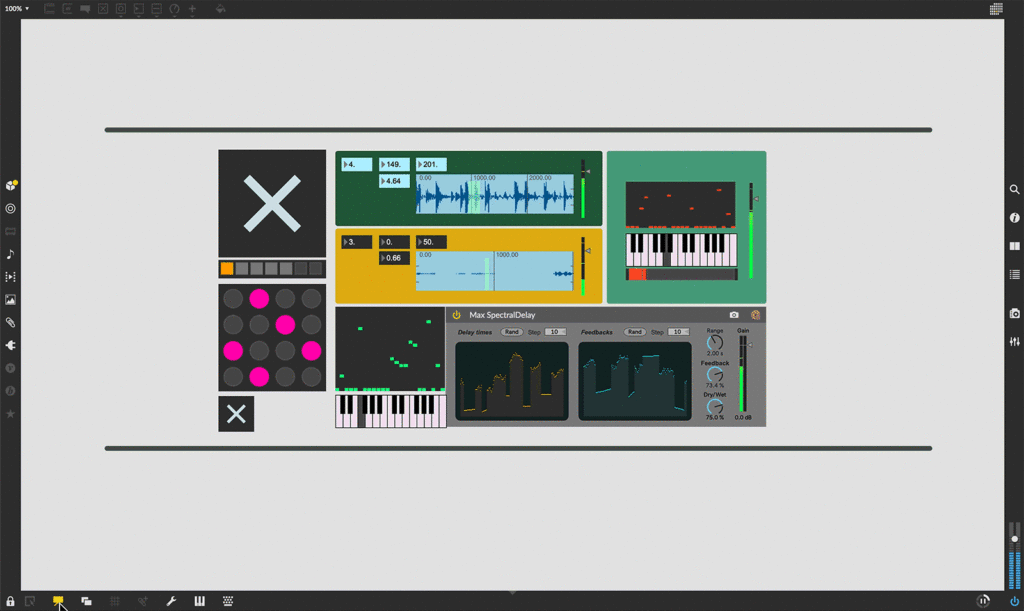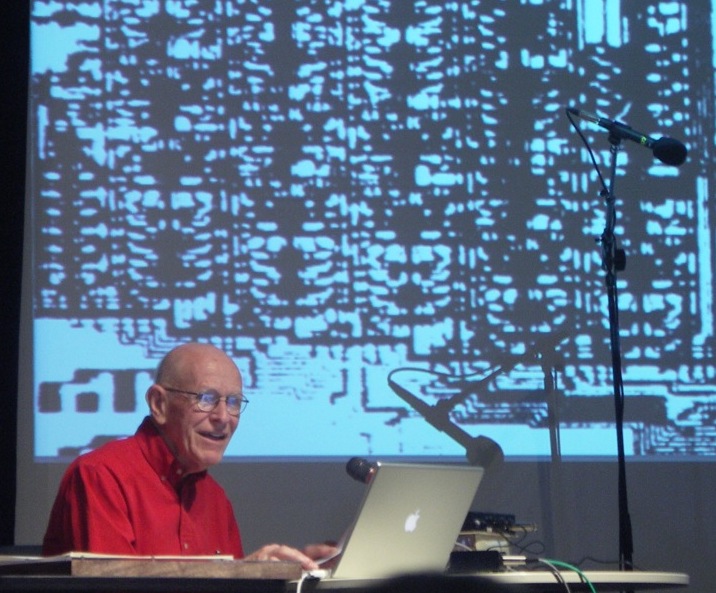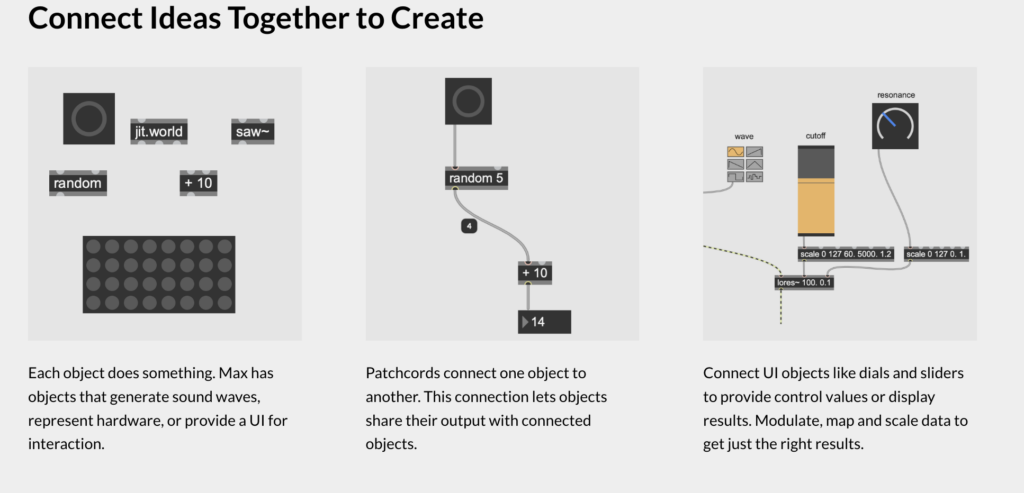Reading Artist-Musicians, Musician-Artists made me think about how blurry the line between disciplines really is, and maybe always has been. Looking up Paul Klee’s work was also interesting as he literally structured his paintings like musical compositions. It reminded me of how we use TidalCycles and Hydra, where coding becomes a tool to create a hybrid performance, a balance between live, rhythmic, and visual elements. Also, the part about intensity over virtuosity also stood out. It made me think of how, in live coding, it’s not about being super polishedl it’s about being present and responsive. Mistakes, randomness, and improvisation are part of the experience, and sometimes even enhance it. Sometimes in Tidal, we throw in randomness just to see what the system gives back. That unpredictability feels exciting, like giving up some control and letting the tool collaborate with you. What I found especially interesting was how often artists, like Cornelia Schleime, shifted between disciplines because they had to, whether it was due to censorship, economics, or needing a new form to express something. It made me realize that interdisciplinary practice isn’t always just an aesthetic choice, it often carries a sense of urgency or necessity. Are labels like artist, musician, or performer even useful anymore? Or are they just there for institutions and funding applications? When we do live coding, these lines feel less and less relevant.
Parkinson and Bell’s article does a great job framing live coding within a spectrum of liveness, with Deadmau5 on one end, focused on spectacle and precision, and Derek Bailey on the other, showcasing spontaneous and real-time improvisation. I found it really interesting how live coding pulls from both these phenomena but carves out its own identity by treating the laptop as an instrument rather than just a playback device.
What resonated with me most was the idea of visibility and transparency, and how projecting the code live makes the compositional process part of the performance. It’s such a contrast to Deadmau5’s polished, pre-sequenced sets. Live coding feels more vulnerable and dynamic, where the performer navigates unpredictability in real time, almost like letting the laptop “speak.”I also liked the comparison to Bailey’s idea of the “instrumental impulse”, and that deep, expressive interaction with the tool. It reminded me that live coding isn’t just about technical skill, but about exploring and responding to the moment. In the end, the piece made me rethink what “live” performance really means, and how it’s not just about physical gestures, but about decision-making, presence, and risk.
Inspired by a p5.js sketch I had created during Intro to IM:
P5 Code:
let baseSize = 40;
let p5 = new P5();
s0.init({ src: p5.canvas });
p5.hide();
p5.frameRate(30);
p5.setup = () => {
p5.createCanvas(400, 400);
};
p5.draw = () => {
p5.background(220, 220, 220, 40);
let cc0 = (typeof cc !== 'undefined' && cc[0] != null) ? cc[0] : 0;
let cc1 = (typeof cc !== 'undefined' && cc[1] != null) ? cc[1] : 0;
// determine mode:
// Mode 0: Grid of ellipses (cc0 < 0.33)
// Mode 1: Rotating lines (0.33 ≤ cc0 < 0.66)
// Mode 2: Central blob (cc0 ≥ 0.66)
let mode = cc0 < 0.33 ? 0 : cc0 < 0.66 ? 1 : 2;
// map cc1 to color values
let r = p5.map(cc1, 0, 1, 50, 255);
let g = p5.map(cc1, 0, 1, 100, 200);
let b = p5.map(cc1, 0, 1, 150, 255);
p5.noStroke();
if (mode === 0) {
// mode 0: Grid of ellipses
let spacing = p5.map(p5.mouseX, 0, p5.width, 20, 50);
let size = baseSize * (1 + cc1) + p5.map(p5.mouseY, 0, p5.height, 0, 20);
for (let x = 0; x < p5.width; x += spacing) {
for (let y = 0; y < p5.height; y += spacing) {
p5.fill(
p5.random(r - 20, r + 20),
p5.random(g - 20, g + 20),
p5.random(b - 20, b + 20),
120
);
p5.ellipse(x, y, size, size);
}
}
} else if (mode === 1) {
// mode 1: Rotating lines
p5.push();
p5.translate(p5.width / 2, p5.height / 2);
let numLines = 12 + Math.floor(cc1 * 12) + Math.floor(p5.map(p5.mouseX, 0, p5.width, 0, 6));
let step = p5.TWO_PI / numLines;
let speed = 0.02 + p5.map(p5.mouseY, 0, p5.height, 0, 0.05);
for (let i = 0; i < numLines; i++) {
let angle = i * step + p5.frameCount * speed;
let len = 100 + cc1 * 100;
p5.stroke(r, g, b, 150);
p5.strokeWeight(2);
p5.line(0, 0, len * p5.cos(angle), len * p5.sin(angle));
}
p5.pop();
} else if (mode === 2) {
// mode 2: Central blob multiple rotated polygons
p5.push();
p5.translate(p5.width / 2, p5.height / 2);
let copies = 6 + Math.floor(cc1 * 6) + Math.floor(p5.map(p5.mouseX, 0, p5.width, 0, 4));
let step = p5.TWO_PI / copies;
for (let i = 0; i < copies; i++) {
p5.push();
p5.rotate(i * step + p5.frameCount * 0.01 + p5.map(p5.mouseY, 0, p5.height, 0, 0.05));
p5.fill(r, g, b, 180);
let sides = 5 + Math.floor(cc1 * 5) + Math.floor(p5.map(p5.mouseY, 0, p5.height, 0, 3));
let radius = 50 + cc1 * 50;
p5.beginShape();
for (let j = 0; j < sides; j++) {
let a = p5.map(j, 0, sides, 0, p5.TWO_PI);
p5.vertex(radius * p5.cos(a), radius * p5.sin(a));
}
p5.endShape(p5.CLOSE);
p5.pop();
}
p5.pop();
}
};
src(s0)
.modulate(noise(3, 0.2), 0.05)
.blend(osc(10, 0, 1).rotate(0.1), 0.1)
.out(o0);
render(o0);
// hush()
Tidal:
d1 $ slow 2 $ s "house(4,8)" # gain 0.9
d2 $ stack [s "drum(4,8) realclaps(4,8)" # speed 4 ,ccv "<64 0 127 0>" # ccn "0" # s "midi"]
d3 $ stack [ s "popkick(8,16)" # speed 3 , ccv "<32 96 127 64>" # ccn "1" # s "midi" ]
d5 $ stack [ s "pad(4,8)" # speed 1.5, ccv "<127 64 32>" # ccn "2" # s "midi" ]
d5 silence
Output (please disregard the audio quality, my microphone was not working properly):
I was inspired by the theory of the backrooms for this composition. Since I already wanted to go for something creepy/eerie, the video I found of the backrooms with the random visuals fit perfectly.
I wanted to start with calm and distant music, gradually introducing the more distorted and abnormal sounds, as this was happening, I simultaneously changed the visuals to make more and more intense, often being modified with the sounds. The climax was supposed to be reached towards the end of the composition when the visuals got more and more intense/red and bright, and the music got more and more creepy, finishing with the numbers track.
Tidal Code:
d1 $ stack [
slow 4 $ s "pad:1.5" # gain 0.5,
s "bass*2" # room 0.3 # gain 1.2
]
d2 $ stack [
s "haw(4,8) blue(4,8)" # speed 0.5 ,
ccv "<64 0 127 0>" # ccn "0" # s "midi"
]
d2 $ stack [
slow 1 $ s "moog" >| note (arp "up" (scale "major" ("[0,2,4,6]") + "a5"))# room 0.4 # gain 0.7,
ccv "<0 64 127 64>" # ccn "0" # s "midi"
]
-- # room 0.4 # gain 0.5,
d2 $ stack [
slow 1 $ s "moog" >| note (arp "up" (scale "major" ("[0,2,4,6]") + "a5")) # room 0.4 # gain 0.7,
ccv 0 # ccn 1 # s "midi"
]
-- # krush 10
d1 $ fast 2 $ s "moog" >| note (arp "up" (scale "major" ("[0,2,4,6]") + "a5")) # room 0.4 # gain 1 # squiz 0.3
-- # squiz 0.1
-- note "a5"
-- add this d4 $ fast 2 $ s "stab*2 stab*2 stab*2 <stab*6 [stab*2]!3>" # room 0.7 # gain (range 1.2 1.4 rand)
d4 $ fast 2 $ s "stab*2 stab*2 stab*2 <stab*6 [stab*2]!3>" # room 0.7 # gain 1.3
d1 $ stack [
slow 2 $ s "bassfoo" >| note (arp "updown" (scale "major" ("[0,2,4,6]"+"<0 0 2 3>") + "c2")) # room 0.4 # delay 0.9,
ccv "<127 0 64 >" # ccn "0" # s "midi"
-- add squiz and have it distort image
-- hydra 2
]
d1 $ slow 2 $ ccv " 127 64" # ccn "0" # s "midi"
d3 $ stack [
slow 4 $ s "pad:1.5" # gain 0.1,
s "bass*2" # room 0.5 # gain 0.1
]
d2 $ stack [
s "haw(4,8) blue(4,8)" # speed 0.5 # gain 0.5,
ccv "<64 0 127 0>" # ccn "0" # s "midi"
]
d3 silence
d4 silence
d1 silence
-- d4 $ fast 2 $ s "stab*2 stab*2 stab*2 <stab*6 [stab*2]!3>" # room 0.7 # gain (range 1.2 1.4 rand)
d2 $ slow 2 $ s "[~numbers:1] [numbers:2] [~numbers:3] [numbers:4] [numbers:5] [numbers:6] [~numbers:7] [numbers:8*2]" # squiz 1.5 # gain 1.2
d3 $ slow 2 $ s "[numbers:1*2] [numbers:2] [numbers:3] [numbers:4] [numbers:5] [numbers:6] [numbers:7] [numbers:8]" # note "c'maj e'min d'maj" # room 0.4 # squiz 2
hush
Hydra Code:
s0.initVideo("/Users/kween/Desktop/Spring 2025!/LiveCoding/0.mp4")
src(s0).out()
src(s0)
.saturate(0.8)
.contrast(1.1)
.modulate(noise(1, 0.1), 0.15)
.modulateScrollX(osc(2, 0.1, 1), 0.05)
.brightness(-0.1)
.out()
src(s0)
.brightness(() => cc[0] * 0.5 - 0.5)
.out()
src(s0)
.blend(src(o0).diff(s0).scale(() => cc[1] * 1),1)
.modulatePixelate(noise(2,0.01).pixelate(16,16),1024)
.out()
src(s0)
.modulate(noise(() => cc[0] * 2, 0.2))
.color(0.4, 0.1, 0.1)
.contrast(1.5)
.brightness(0.3)
.modulateScale(voronoi(5, 0.3))
.rotate(() => Math.sin(time) * 0.1)
.out(o0)
src(s0)
.blend(src(o0).diff(s0).scale(.99),1.1)
.modulatePixelate((noise(() => cc[0] * 2, 0.1)).pixelate(() => cc[0] * 2,16),1024)
.out()
src(s0)
.blend(src(o0).diff(s0).scale(.99),1.1)
.out()
//end?
src(s0)
.modulate(noise(() => cc[1] * 2, 0.1))
.colorama(() => cc[0] * 0.5)
.rotate(() => Math.sin(time) * 0.2)
.color(1, 0.2, 0.2)
.out()
src(s0)
.blend(src(o0).diff(s0).scale(.99),1.1)
.modulate(noise(() => cc[1] * 2, 0.1))
.colorama(() => cc[0] * 0.5)
.rotate(() => Math.sin(time) * 0.2)
.color(1, 0.2, 0.2)
.out()
src(s0).out()
hush()
I’m going for a dark/sinister vibe for the piece, I’m still trying to nail down the sounds and make them match the visuals better, as well as try and get better/more captivating visuals on hydra.
Ryoichi Kurokawa’s work is a powerful combination of sensory experiences and personal philosophy. One of the most striking aspects of his practice is his use of synaesthesia and the deconstruction of nature, as well as the duality between them within his projects. The way he merges sound and visuals into an interconnected experience is especially unique. Rather than treating these two elements as separate, Kurokawa creates compositions where sound influences visuals and vice versa, similar to what we have been exploring in class. Another compelling aspect of his work is how he takes fragmented representations of nature and reconstructs them digitally in a way that feels both familiar and transformed.
There is a strong duality between synaesthesia and nature; on one hand, his work is deeply inspired by organic patterns and natural phenomena, yet on the other, it is highly structured and manipulated through technology. This contrast between natural and artificial, order and chaos, reality and abstraction makes his work particularly thought-provoking, pushing us to question what is “real” versus what has been digitally reimagined.
Kurokawa also pushes the boundaries of live coding, going beyond traditional text-based programming and into real-time audiovisual compositions. Unlike conventional live coding, where the focus is on writing and executing code in the moment, Kurokawa creates intricate environments that blend pre-structured elements with real-time transformations. His approach combines live performance with generative art, making his work feel both organic and digital, structured yet fluid. By deconstructing and reconstructing natural elements like water ripples and geological formations, he builds immersive audiovisual ecosystems where the line between pre-composed and real-time elements becomes blurred. His work redefines live coding not just as a technical process but as a deeply immersive and evolving digital experience that bridges the natural and the computational.
Beyond his art, I also found Kurokawa’s personal approach to creativity intriguing, especially the fact that he does not have internet access in his home studio. In a world where digital connectivity is almost inescapable, this choice reflects his deliberate method of working by eliminating distractions to fully immerse himself in his creative process. It also highlights his deep dedication to his craft, which is evident in the intensity and focus of his work.
Max is a visual programing language for music and multimedia. It is used by composers, perfomers, software designers, researchers, and artists to create recordings, perfomances, and installations.

Max MSP’s origin can be traced back to the work of Max Mathews, who is often referred to as the father of computer music. In the 1960s, Mathews developed the Music-N series of programming languages. These early languages provided the foundation for digital sound synthesis and influenced many future music programming environments, including Max MSP. Mathews’ contributions laid the groundwork for interactive computer music by demonstrating that computers could generate and manipulate sound in real-time, an idea that continues to drive Max MSP’s development today.

At its core, Max MSP operates through a visual patching system, where users connect objects that perform specific functions, such as generating sound, processing video, or managing data flow. Each object has inputs and outputs that allow users to design complex behaviors by linking them together in an intuitive graphical interface. This modular approach makes it accessible to both beginners and experienced programmers, as it eliminates the need for traditional text-based coding while still offering deep customization and extensibility. Additionally, Max supports JavaScript, Java, and C++ integration, enabling users to create custom objects and extend the software’s capabilities beyond its built-in tools. Another key strength of Max MSP is its seamless integration with hardware and external devices. It supports MIDI and OSC (Open Sound Control), making it compatible with a wide range of musical instruments, synthesizers, and external controllers. Additionally, it can interface with Arduino, Raspberry Pi, and other microcontrollers, allowing users to build interactive installations.

Max MSP is considered a live coding platform due to its real-time interaction capabilities. Unlike traditional programming languages, where code must be compiled before execution, Max allows users to modify patches on the go, adjusting parameters, adding new elements, and altering behavior without stopping the performance. This flexibility makes it particularly valuable in live music, audiovisual performances, and interactive installations.
My demo: